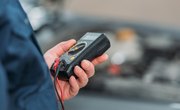
The First Magnetometer
When you want to figure out the strength or direction of a magnetic field, a magnetometer is your tool of choice. They range from the simple--you can make one in your kitchen easily--to the complex, and the more advanced devices are regular passengers on space exploration missions. The first magnetometer was created by Carl Friedrich Gauss, who is often called "the Prince of Mathematics," and who published a paper in 1833 describing a new device he called a "magnometer." His design is very similar to the simple magnetometer described below, which you can create in your kitchen.
Types
Because they are very sensitive, magnetometers can be used to find archaeological sites, iron deposits, shipwrecks and other things that have a magnetic signature. A network of magnetometers around the earth constantly monitors minute effects of the solar wind on the earth's magnetic field and publishes the data on the K-index (see Resources). There are two basic types of magnetometers. Scalar magnetometers measure the strength of a magnetic field, while vector magnetometers measure the compass direction.
Creating Your Own
There is a simple vector magnetometer that you can make yourself. A bar magnet, hanging from a thread, will always point north; by marking one end of it, you can spot small variations as the magnetic field changes. By adding a mirror and light, you can take fairly accurate measurements and detect the effects of magnetic storms (for full instructions, see the Suntrek link in Resources).
The Hall Effect
More complicated magnetometers, such as those used on spacecraft, use a variety of methods to detect magnetic field strength and detection. The most common magnetometers are called Solid-State Hall Effect sensors. These sensors use properties of electrical current that are affected by the presence of a magnetic field that does not run parallel to the direction of the current. When there is a magnetic field present, the electrons (or their opposite, electron holes, or both) in the current gather on one side of the conductive material. When it is absent, the electrons or holes run in a basically straight line. The way a magnetic field affects the motion of the electrons or holes can be measured and used to determine the direction of a magnetic field. Hall Effect sensors also produce a voltage that is proportional to the strength of the magnetic field, making them both vector and scalar magnetometers.
Magnetometers in Daily Life
We often encounter magnetometers in our daily lives, though you might not know it, in the form of metal detectors. Hand-held metal detectors used by treasure hunters and hobbyists use the Hall Effect to locate metallic objects. Using a phenomenon known as phase shifting, detectors can differentiate between metals by measuring the resistance or inductance (conductivity) of the object.
Resources
